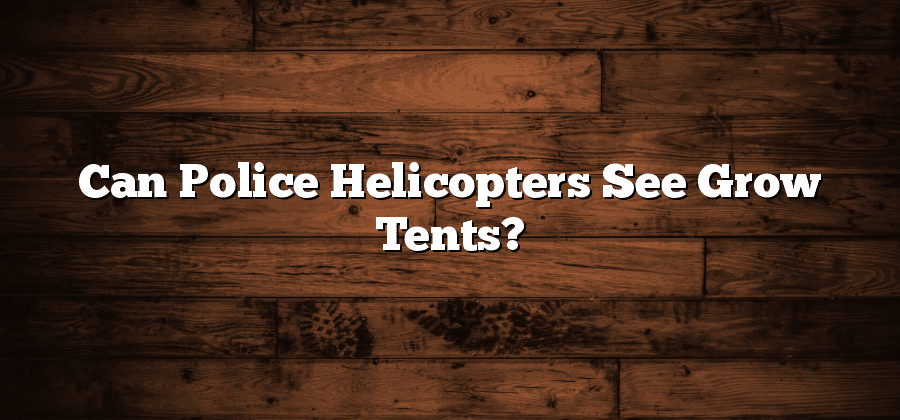Police Helicopter Surveillance and Indoor Grow Operations
Police helicopters play a crucial role in crime prevention and law enforcement activities. With their advanced technology and aerial vantage point, they provide valuable assistance to police departments in various operations. One area where police helicopter surveillance has proven to be particularly effective is in detecting and monitoring indoor grow operations.
Indoor grow operations, especially illicit ones, pose significant risks to communities due to the potential for fire hazards, electrical problems, and the use of harmful chemicals. These operations often involve the cultivation of illegal drugs, such as marijuana, within concealed spaces like residential homes or commercial buildings. By utilizing their high-resolution cameras and thermal imaging capabilities, police helicopters can detect and document suspicious activities related to indoor cultivation. This helps law enforcement agencies to identify and dismantle these operations, thereby protecting public safety and reducing the supply of illegal substances in our communities.
The Role of Police Helicopters in Crime Prevention
Police helicopters play a significant role in crime prevention, providing a unique vantage point from the sky for law enforcement agencies. Their ability to cover large areas quickly and effectively makes them a valuable asset in keeping communities safe. Equipped with advanced surveillance technology, these helicopters provide crucial support to ground officers by assisting in locating suspects, monitoring criminal activities, and maintaining public order.
One primary function of police helicopters in crime prevention is their ability to track and pursue fleeing suspects. From high above, they can quickly identify suspects’ movements, monitor their routes, and coordinate with ground units to apprehend them swiftly. Additionally, the presence of a police helicopter overhead often acts as a deterrent, discouraging criminals from engaging in illegal activities due to the potential risk of being detected and pursued. This proactive approach not only helps in preventing crimes from occurring but also aids in the apprehension of individuals involved in various criminal acts.
The Technology Behind Police Helicopter Surveillance
One of the key technologies used in police helicopter surveillance is the Forward-Looking Infrared (FLIR) camera system. This cutting-edge technology allows law enforcement agencies to detect heat signatures and provide real-time images to the crew onboard the helicopter. The FLIR camera system is equipped with thermal imaging sensors and advanced software that can track and monitor suspects, even in complete darkness or adverse weather conditions. This technology is crucial in locating individuals who may be hiding or fleeing from the police, as the thermal images can detect their body heat and provide invaluable information to ground units.
Another vital technology utilized in police helicopter surveillance is the Night Vision Imaging System (NVIS). This technology allows law enforcement officers to see clearly in low-light situations, such as during the nighttime or in areas with minimal light sources. The NVIS system amplifies the available light and enhances the visibility, providing the crew with a detailed and clear visual representation of the targeted area or suspect. By utilizing the NVIS technology, police helicopters can effectively gather visual evidence, locate suspects, and support ground units in their crime-fighting efforts. The combination of FLIR and NVIS technologies significantly enhances the effectiveness and efficiency of police helicopter surveillance, making it an invaluable tool in the fight against crime.
Understanding the Purpose of Grow Tents
Grow tents serve an essential purpose in indoor cultivation operations. These specialized structures are designed to provide a controlled environment for plants to thrive and maximize their growth potential. By enclosing the growing area, grow tents allow growers to have full control over key environmental factors such as temperature, humidity, light intensity, and ventilation.
Control over these factors is crucial as it directly impacts the health and productivity of the plants. Grow tents are often made with reflective materials on the interior walls to ensure that the maximum amount of light is reflected back onto the plants. Additionally, these tents are equipped with openings for air vents, allowing growers to regulate airflow and prevent the buildup of stagnant air, which can lead to mold and pest infestations. In this controlled environment, growers can create the optimal conditions for their plants to flourish, resulting in increased yields and higher quality crops.
The Importance of Concealing Indoor Grow Operations
Indoor grow operations have become increasingly popular in recent years, particularly for the cultivation of illegal substances. However, it is essential for individuals involved in these operations to understand the critical importance of concealing their activities. The need for discretion arises from the fact that illegal indoor grow operations not only violate the law, but they also pose significant risks to the individuals involved, the community, and even the environment.
Concealing indoor grow operations is crucial for various reasons. Firstly, it helps to minimize the risk of detection by law enforcement agencies. By keeping their activities hidden, individuals involved in grow operations can reduce the likelihood of facing legal consequences such as criminal charges, fines, or even imprisonment. Moreover, concealing grow operations also protects the privacy and security of the individuals engaged in these activities, shielding them from potential harm that may arise from the disclosure of their illegal operations to criminals or competitors.
Furthermore, the concealment of indoor grow operations is essential to minimize the negative impact on the community and the environment. Unlawful grow operations often require a significant amount of resources, including electricity, water, and chemicals. By successfully concealing these operations, individuals can reduce the strain on local resources and prevent potential hazards, such as electrical fires or toxic waste, which can pose risks to the surrounding community.
In conclusion, the importance of concealing indoor grow operations cannot be overstated. It is not only crucial to avoid legal consequences and protect the individuals involved but also to minimize harm to the community and environment. Therefore, those engaged in indoor grow operations must take appropriate measures to ensure their activities remain discreet and concealed from prying eyes.






